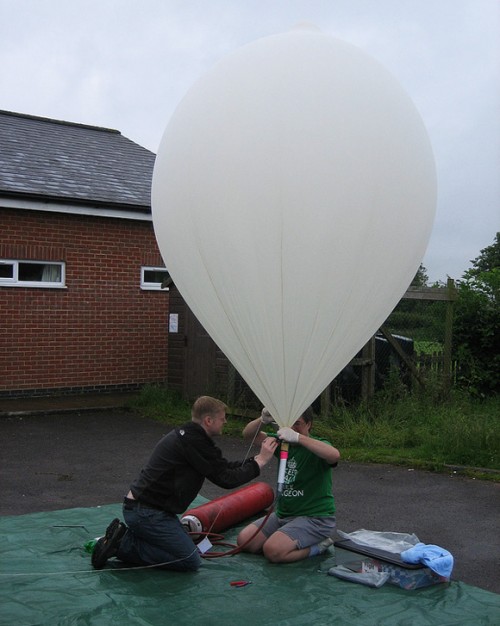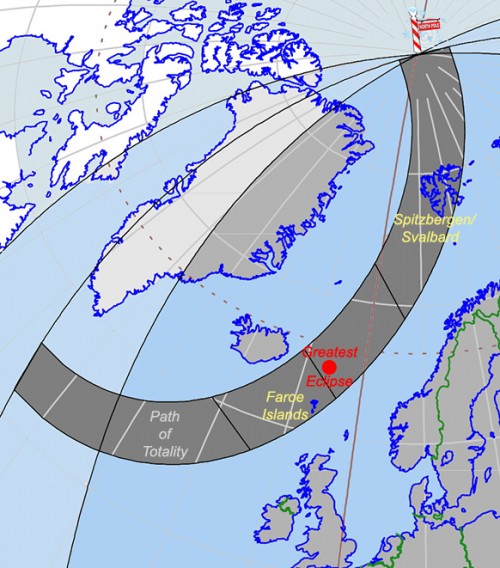| Helen: We’re pleased to welcome back to the blog a regular guest, high-altitude balloonist Dave Akerman. You’ll have gathered that a noteworthy astronomical event is to take place across northern Europe on Friday, and as you’d expect, Dave has plans. We’ll let him tell you all about them. As you have probably heard by now, there will be a total solar eclipse this Friday morning, with the path of totality passing north of the UK and directly over the Faroe Islands.
In the UK we should see about 90% of the sun eclipsed by the moon, with the north of Scotland getting the best view assuming no clouds get in the way. By now you are probably wondering what all this has to do with the Raspberry Pi, and the answer is that I will be flying two Model A+ Pis on a balloon from (no, not the Faroes) Leicester racecourse. Additionally, there will be several more Pi boards decoding the transmissions, and a V2 Pi B+ showing the results on a large monitor. The launch will be at about 8am so that the balloon is nicely high during the peak of the eclipse at about 9:30am.  An earlier launch of a Raspberry Pi with a weather balloon Some of you may have followed some of my previous flights using the online map and live image page. This time though, there’s an extra special option for your viewing pleasure. Live TV. The launch will be recorded by the BBC and some of the footage will be transmitted on an extra BBC Stargazing show on BBC1 that morning (9am to 10am). Also, there will be a couple of very brief live segments where, hopefully, I get to show some pretty live images and say “Raspberry Pi” as often as possible. Assuming we get to recover the flight, then some of the recorded video should end up on the main Stargazing show in the evening (9pm-10pm, BBC2). The plan looked a tad uncertain earlier in the week because weather predictions gave me a choice of landing at Heathrow or Gatwick. I spent a lot of time speaking to the BBC trying to come up with a plan that lets us launch but without getting onto the national news for all the wrong reasons! One rejected plan was to launch from Jodrell Bank (from where the main Stargazing show is broadcast), but for some reason they don’t allow mobile phones or 3G there. Another plan was to underfill the balloon and get it to land near Dieppe in France. As of Wednesday morning, though, predictions are continuing to improve and I’m now confident of getting this flight to land somewhere safe in England, instead of having to trek to France to recover the payload. The reason for launching from Leicester is that the BBC are running a “spectacular live event” from the racecourse, open to the public from 9am to 3pm and then 6pm to 9pm. Entry is free to please do come along if you can. They have a real astronaut and plenty else of interest – see this information page. Also, Leicester is home to the National Space Centre, so there’s plenty to see if you do decide to visit. Helen: If you want to complement the coverage from Dave and the BBC with your own observations, the Royal Astronomical Society and the Society for Popular Astronomy have produced an excellent pdf guide to this Friday’s eclipse, explaining how to view it safely and what you’ll see if cloud cover doesn’t spoil the fun. Remember that cameras, including the Raspberry Pi camera module, are liable to be damaged if you point them directly at the Sun; don’t try direct eclipse photography unless you have the proper filters, but do bear in mind that you can achieve some very pleasing results without any specialist equipment by photographing a pinhole projection of the eclipse. |
A Semi-automated Technology Roundup Provided by Linebaugh Public Library IT Staff | techblog.linebaugh.org
Wednesday, March 18, 2015
Observing a solar eclipse with high-altitude Pis
Subscribe to:
Post Comments (Atom)

No comments:
Post a Comment